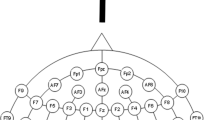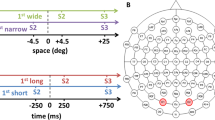Abstract
Previous event-related potential (ERP) studies have suggested a possible participation of the visual cortex of the blind in auditory processing. In the present study, somatosensory and auditory ERPs of blind and sighted subjects were recorded when subjects were instructed to attend to stimuli of one modality and to ignore those of the other. Both modalities were stimulated with frequent (“standard”) and infrequent (“deviant”) stimuli, which differed from one another in their spatial locus of origin. In the sighted, deviant stimuli of the attended modality elicited N2 type of deflections (auditory N2b and somatosensory N250) over the lateral scalp areas. In contrast, in the blind, these ERP components were centroposteriorly distributed, suggesting an involvement of posterior brain areas in auditory and somatosensory stimulus discrimination. In addition, the mismatch negativity, elicited by deviant auditory stimuli even when the somatosensory stimuli were attended, was larger in the blind than in the sighted. This appears to indicate enhanced automatic processing of auditory stimulus changes in the blind. Thus, the present data suggest several compensatory changes in both auditory and somatosensory modalities after the onset of early visual deprivation.
Similar content being viewed by others
References
Alho K, Woods DL, Algazi A, Näätänen R (1992) Intermodal selective attention. II. Effects of attentional load on processing of auditory and visual stimuli in central space. Electroencephalogr Clin Neurophysiol 82:356–368
Alho K, Kujala T, Paavilainen P, Summala H, Näätänen R (1993) Auditory processing in visual brain areas of the early blind: evidence from event-related potentials. Electroencephalogr Clin Neurophysiol 86:418–427
Axelrod S (1959) Effects of early blindness. American Foundation for the Blind, New York
Banks MS, Aslin RN, Letson RD (1975) Sensitive period for the development of human binocular vision. Science 14:675–677
Barry W, Jones GM (1965) Influence of eye lid movement upon electro-oculographic recording of vertical eye movements. Aerosp Med 36:855–858
Benedetti LH, Loeb M (1972) A comparison of auditory monitoring performance in blind subjects with that of sighted subjects in light and dark. Percept Psychophys 11:10–16
Desmedt JE, Tomberg C (1989) Mapping early somatosensory evoked potentials in selective attention: critical evaluation of control conditions used for titrating by difference the cognitive P30, P40, P100 and N140. Electroencephalogr Clin Neurophysiol 74:321–346
Desmedt JE, Tomberg C (1991) The search for ‘neutral’ conditions for recording control event-related potentials in order to assess cognitive components to both irrelevant and relevant stimuli: evidence for short-latency cognitive somatosensory effects. Electroencephalogr Clin Neurophysiol [Suppl] 42:210–221
Dixon WJ, Brown MB, Engelman L, Hill MA, Jennrich RI (1988) BMDP statistical software manual. University of California Press, Berkeley, Calif
Feinsod M, Bach-y-Rita P, Madey JMJ (1973) Somatosensory evoked responses: latency differences in blind and sighted persons. Brain Res 60:219–223
Fisher GH (1964) Spatial localization by the blind. Am J Psychol 77:2–13
Hackley SA, Woldorff M, Hillyard SA (1990) Cross-modal selective attention effects on retinal, myogenic, brainstem and cerebral evoked potentials. Psychophysiology 27:195–208
Hyvärinen J, Carlson S, Hyvärinen L (1981a) Early visual deprivation alters modality of neuronal responses in area 19 of monkey cortex. Neurosci Lett 26:239–243
Hyvärinen J, Hyvärinen L, Linnankoski I (1981b) Modification of parietal association cortex and functional blindness after binocular deprivation in young monkeys. Exp Brain Res 42:1–8
Korte M, Rauschecker JP (1993) Auditory spatial tuning of cortical neurons is sharpened in cats with early blindness. J Neurophysiol 70:1717–1721
Kujala T, Alho K, Paavilainen P, Summala H, Näätänen R (1992) Neural plasticity in processing of sound locations by the early blind: an event-related potential study. Electroencephalogr Clin Neurophysiol 84:469–472
Kujala T, Huotilainen M, Sinkkonen J, Ahonen AI, Alho K, Hämäläinen MS, Ilmoniemi RJ, Kajola M, Knuutila JET, Lavikainen J, Salonen O, Simola J, Standertskjöld-Nordenstam C-G, Tiitinen H, Tissari SO, Näätänen R (1995) Visual cortex activation in blind humans during sound discrimination. Neurosci Lett 183:143–146
Mäntysalo S, Näätänen R (1987) The duration of a neuronal trace of an auditory stimulus as indicated by event-related potentials. Biol Psychol 24:183–195
Merzenich MM, Recanzone G, Jenkins WM, Allard TT, Nudo RJ (1988) Cortical representational plasticity. In: Rakic P, Singer W (eds) Neurobiology of Neocortex. Wiley, New York, pp 41–67
Näätänen R (1992) Attention and brain function. Erlbaum, New York
Näätänen R, Simpson M, Loveless NE (1982) Stimulus deviance and evoked potentials. Biol Psychol 14:53–98
Neville H, Lawson D (1987) Attention to central and peripheral visual space in a movement detection task: an event-related potential and behavioural study. II. Congenitally deaf adults. Brain Res 405:268–283
Neville HJ, Schmidt A, Kutas M (1983) Altered visual-evoked potentials in congenitally deaf adults. Brain Res 266:127–132
Niemeyer W, Starlinger I (1981) Do the blind hear better? Investigations on auditory processing in congenital or early acquired blindness. II. Central functions. Audiology 20:510–515
Novak G, Ritter W, Vaughan HG Jr (1990) The chronometry on attention-modulated processing and automatic mismatch detection. Psychophysiology 29:413–430
Novak G, Ritter W, Vaughan HG Jr, Wiznitzer ML (1992) Differentiation of negative event-related potentials in an auditory discrimination task. Electroencephalogr Clin Neurophysiol 75:255–275
Rauschecker JP, Kniepert U (1994) Auditory localization behaviour in visually deprived cats. Eur J Neurosci 6:149–160
Rauschecker JP, Korte M (1993) Auditory compensation for early blindness in cat cerebral cortex. J Neurosci 13:4538–4548
Rauschecker JP, Tian B, Korte M, Egert U (1992) Crossmodal changes in the somatosensory vibrissa/barrel system of visually deprived animals. Proc Natl Acad Sci USA 89:5063–5067
Ryugo DK, Ryugo R, Globus A, Killackey HP (1975) Increased spine density in auditory cortex following visual or somatic deafferentation. Brain Res 90:143–146
Sakurabayashi H, Sato Y, Uehara E (1956) Auditory discrimination of the blind. J Psychol Blind (Psychological Abstracts) 1:3–10
Sams M, Paavilainen P, Alho K, Näätänen R (1985) Auditory frequency discrimination and event-related potentials. Electroencephalogr Clin Neurophysiol 62:437–448
Strelow ER, Brabyn JA (1982) Locomotion of the blind controlled by natural sound cues. Perception 11:635–640
Uhl F, Franzen P, Lindinger G, Lang W, Deecke L (1991) On the functionality of the visually deprived occipital cortex in early blind persons. Neurosci Lett 124:256–259
Uhl F, Franzen P, Podreka I, Steiner M, Deecke L (1993) Increased regional cerebral blood flow in inferior occipital cortex and cerebellum of early blind humans. Neurosci Lett 150:162–164
Veraart C, De Volder AG, Wanet-Defalque MC, Bol A, Michel C, Goffinet AM (1990) Glucose utilization in human visual cortex is abnormally elevated in blindness of early onset but decreased in blindness of late onset. Brain Res 510:115–121
Wanet-Defalque M-C, Veraart C, De Voider A, Metz R, Michel C, Dooms G, Goffinet A (1988) High metabolic activity in the visual cortex of early blind human subjects. Brain Res 446:369–373
Wiesel TN (1982) Postnatal development of the visual cortex and the influence of environment. Nature 299:583–591
Winkler I, Näätänen R (1992) Event-related potentials in auditory backward recognition masking: a new way to study the neurophysiological basis of sensory memory in humans. Neurosci Lett 140:239–242
Winkler I, Paavilainen P, Alho K, Reinikainen K, Sams M, Näätänen R (1990) The effect of small variation of the frequent auditory stimulus on the event-related potential to the infrequent stimulus. Psychophysiology 27:228–235
Woods DL, Clayworth CC, Bach-y-Rita P (1985) Early blindness reorganizes auditory processing in humans. Soc Neurosci Abstr 15:449
Woods DL, Alho K, Algazi A (1992) Intermodal selective attention. I. Effects on event-related potentials to lateralized auditory and visual stimuli. Electroencephalogr Clin Neurophysiol 82:341–355
Yamaguchi S, Knight RT (1992) Effects of temporal-parietal lesions on the somatosensory P3 to lower limb stimulation. Electroencephalogr Clin Neurophysiol 84:139–148
Author information
Authors and Affiliations
Rights and permissions
About this article
Cite this article
Kujala, T., Alho, K., Kekoni, J. et al. Auditory and somatosensory event-related brain potentials in early blind humans. Exp Brain Res 104, 519–526 (1995). https://doi.org/10.1007/BF00231986
Received:
Accepted:
Issue Date:
DOI: https://doi.org/10.1007/BF00231986




